|
Four hundred years ago in 1609 the plague hit Wall Hills. It is thought about ten people died of the disease including Michaell Hall, son of Francis Hall of Bromyard. Michaell was buried at St. Michael and All Angels church on the 16th October 1610.
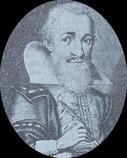 In 1605 John Davies of Hereford (1565 - 1618) was writing descriptions of the plague in poetic form: In 1605 John Davies of Hereford (1565 - 1618) was writing descriptions of the plague in poetic form:
Witness our Citties, Townes and Villages,
Which Desolation, day and night, invades
With Coffins (Cannon-like) on Carriages,
With trenches ram'd with Carkases with Spades!
A shiv'ring cold (I sensibly do feele)
Glides through my veines, and shakes my hart and hand
When they doe prove their vertue, to reveale
This plague of plagues, that overlades this Land!
Horror stands gaping to devoure my Sense
[Extracts from The Triumph of Death or The Picture of the Plague: According to the Life, as it was in AD 1603 by John Davies of Hereford]
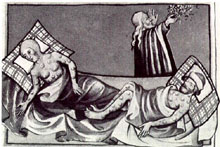 From the Fourteenth to Seventeenth Centuries the bubonic plague caused by the bacterium Yersina pestis periodically ravaged both Asia and Europe. It has been estimated that 60% of Europe's population was lost to the plague. From the Fourteenth to Seventeenth Centuries the bubonic plague caused by the bacterium Yersina pestis periodically ravaged both Asia and Europe. It has been estimated that 60% of Europe's population was lost to the plague.
Originating in Central Asia 100,000 years ago Yersina pestis lived harmlessly in burrowing marmots. Eventually blood-sucking fleas hosting the bacterium spread to black rats that had no protection from the bacterium. When the rats first reached Constantinople in AD 542 an estimated 10,000 people were dying of the plague every day. The door to Europe had been opened.
The 'Black Death' (1347 - 1351) reached England where it was also known as 'Great Plague of England'. It has been estimated that 50 million Europeans fell victim to the plague in 1348 alone.
Th' Almighties hand that long had, to his paine,
Offer'd to let his Plagues fall, by degrees,
And with that offer pull'd it backe againe,
Now breakes his Viall, and a plague out-flees,
That glutts the Aire with Vapors venemous;
That puttrifie, infect, and flesh confound,
And makes the Earthes breath most contagious,
That in the Earth and Aire but Death is found.
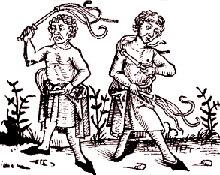 The church taught that the plague was sent as a punishment by God to wipe out sinners. It was generally believed that the plague was transmitted through the foul smelling air that emanated from plague victims. However, lacking scientific wisdom, some also believed that you could catch it just by looking at a plague victim. The church taught that the plague was sent as a punishment by God to wipe out sinners. It was generally believed that the plague was transmitted through the foul smelling air that emanated from plague victims. However, lacking scientific wisdom, some also believed that you could catch it just by looking at a plague victim.
Flagellants would walk around towns whipping themselves as a practice of mortification of the flesh. This was performed as a penance.
No Phisicke could be found, to be a meane,
But to allaie their Paine, delaie their Death;
In this Phisitions Harvest, They could gleane
But corrupt Aire and Danger by that Breath.
All Artes and Sciences were at a stand,
And All that liv'd by them did die;
For death did hold their heads, and staid their hand,
Sith they no where could use their Facultie.
The nursing Mothers of the Sciences,
Withdrew their Foster-milke while witt did fast;
For, both our forlorne Universities
Foresaken were, and Colledges made fast!
Physicians of the period had no practical cure for the plague. Their medicine was based in the shamanistic complex that involved notions of destiny, sin and astronomy, which was allied to the ancient Greek theory of the four humors. 'Cures' were often as bizarre as they were useless. Blood-letting was common in the C18th in an attempt to create balance between the four humors.
Various herbs were seen as beneficial and when tobacco became popular, smoking was promoted as a way to dispel the foul air of the plague. Similarly farting into a bottle, which when later uncorked could chase away this foulness. The brains of a young man (having died violently) was mashed with a little wine and then mixed with horse dung. This prepared 'cure' needed to be left for a year to mature before being taken. Dried scabs from plague sores would be eaten in an almost homeopathic type cure.
He laies it on the skinnes of Yong and Old,
The mortall markes whereof therein appeare:
Here, swells a Botch, as hie as hide can hold,
And Spots (his surer Signes) do muster there!
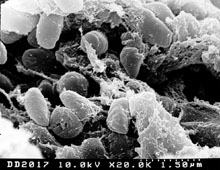 Yersina pestis would kill one third of its victims within 5 days. It is a disease of the lymphatic system that invades your blood, skin, lungs and other vital organs. It begins with headaches and fever and produces lumps that swell to the size of apples in your armpits and groin; these ooze with pus and blood. You are spitting and urinating your own blood. Every cough spreads the disease further. Purple-black blotches (lumps of bacteria) appear on your skin. You smell worse than death itself. It can kill in three days. Yersina pestis would kill one third of its victims within 5 days. It is a disease of the lymphatic system that invades your blood, skin, lungs and other vital organs. It begins with headaches and fever and produces lumps that swell to the size of apples in your armpits and groin; these ooze with pus and blood. You are spitting and urinating your own blood. Every cough spreads the disease further. Purple-black blotches (lumps of bacteria) appear on your skin. You smell worse than death itself. It can kill in three days.
Now like to Bees, in Summers heate, from hives,
Out flie the Citizens, some here, some there;
Some all alone, and otheres with their wives:
With wives and children some flie, All for feare
Here stands a Watch with guard of Partezans
To stoppe their Passages, or too, or fro;
As if they were nor Men, nor Christians,
But Fiends, or Monsters, murdring as they go!
When the plague struck it tended to hit the cities such as London first. The wealthier inhabitants would flee to the countryside and so spread the plague further still. In 1665 the village of Eyam in Derbyshire became infected from some cloth that had been sent from London. The local tailor was its first victim. The villagers led by their priest bravely decided to quarantine their own village. By the following Spring out of the 350 villagers only 84 had survived.
Heere goes a husband heavily to seeke
A Grave for his dead wife (now hard to have)
A wife there meets him that had done the like,
All which (perhaps) are buried in one Grave.
The last survivor of a Familie,
Which yesterday (perhaps) were all in health,
Now dies to beare his fellowes company,
And for a Grave for all, gives all their wealth.
During the archaeological excavations at Hereford Cathedral Close in 1993 three mass grave pits were discovered with indications that up to 400 people had been buried there. Thin layers of clay were found which covered several bodies at a time. Archaeologists believe this clay covering would have protected from the stench of the plague and the decaying bodies as well as an attempt to ward off any further infection.
No place was free for Free-man; ne for those
That were in Prisons, wanting Libertie;
Yet Prisoners freest were from the Plagues and Woes
That visite Free-men, but too lib'rally.
For, al their food came from the helthy house,
Which then wold give Gods plags from thence to keep;
The rest, shut up, could not like bountie use,
So, woefull Pris'ners had least cause to weepe.
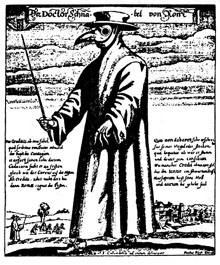 No one was truly safe from the plague, although it was understood that people isolated from the rest of society had a better chance of not coming into contact with it. Physicians who administered cures to the wealthy had a bizarre dress code that helped them remain free of the plague. Dressed in ankle length robes, gloves and boots to protect their body, and a beak-shaped primitive gas mask on their heads they prescribed bathing in urine, applying crushed toads to plague sores and puppy guts to fevered foreheads. No one was truly safe from the plague, although it was understood that people isolated from the rest of society had a better chance of not coming into contact with it. Physicians who administered cures to the wealthy had a bizarre dress code that helped them remain free of the plague. Dressed in ankle length robes, gloves and boots to protect their body, and a beak-shaped primitive gas mask on their heads they prescribed bathing in urine, applying crushed toads to plague sores and puppy guts to fevered foreheads.
A Beggars home (though dwelling in a Ditch
If farre from London it were scituate)
He might rent out if pleas'd him to the Rich
That now as Hell their London homes doe hate.
While King James I (1603 - 1625) fled from place to place around his kingdom to escape the plague, others were far less fortunate. In late C16th and C17th London plague victims' houses would be locked and bolted from the outside leaving the entire family to die within. Baskets would be lowered from upstairs windows for the watchmen to put food into. The gruesome task of removing bodies was undertaken at night by labourers with death carts. Bodies would be wrapped in makeshift shrouds and taken for hasty burial in the plague pits.
Repent, repent (like Ionas) now they crie,
Ye men of England, O repent, repent;
To see if so yee maie move Pitties Eye,
To look upon you, ere you quite be spent.
In March 1349 John Prato, chaplain of the chantry of the Blessed Virgin in Ledbury parish church died of the plague. He was followed by 'Sir Roger' and Brother Gilbert de Middleton the Master of St Katherine's. During the next six months three priests died of the plague at Bosbury and two at Evesbatch. Other clergymen were taken by the plague at Ledbury, Bromsberrow, Munsley, Donnington and Canon Frome. The last recorded local death in 1349 was John Golafre, the vicar of Little Marcle. Two further plague deaths occurred in 1350: one at Coddington and another, Stephen de Estenore (of Eastnor) in July. Records show that only three local clergy escaped the plague - at Colwall, Pixley and Aylton.
Records of plague deaths suffered by the brethren and laymen of Ledbury were not recorded at St Katherine's. However, it has been estimated that 40-45% of the population was struck down.
Further outbreaks occurred: The 'Grey' Death in 1361; lesser outbreaks in 1368-9 and 1375, which was followed by another larger epidemic in 1391.
The Land is scarse, but yet the Seed is cheape,
For, all is full, or rather overfill'd.
The Beere is laid away, and Cribbes they get,
To fetch more dung for Fields and Garden plots;
Worke-men are scarse, the labour is so great,
That (ah) the Seede, unburied, often rottes.
It rottes, and makes the Land thereby the worse,
For being rotten, it ill vapors breedes;
Which many mortall miseries doe nurse
And the Plague (overfed) so, overfeedes.
Here lies a humane Carcasse halfe consum'd;
And there some sow or beast in selfe same plight;
Dead with the Pestilence, for so it fum'd,
That all it touched, it consum'd quite.
The acute labour shortage that the plague caused was at first a blessing for labourers. As land was left unfarmed landowners became so desperate that wages in some places doubled. Annual rents were falling too as St Katherine's estates' records reveal: In 1314 the annual rents from Hyde, Cradley were £1 18s. However, by 1349 only Hugh Schyppathe's rent at Hyde remained paid at 2s 6d.
Villein services (such as meadow mowing, hay lifting and pannage) on hospital villein land were becoming rarer and rarer and by 1397 St Katherine's demesne economy had completely collapsed. The land was neither worked for the benefit of the landowner nor was it farmed by the landowner. Following the example of the bishops of Worcester the master of St Katherine's leased out all the hospital lands to laymen.
However, it was soon discovered that the new rent money that the master of St Katherine's, William Pykesley, received had corrupted him. Pykesley was accused of serious maladministration as the hospital failed to provide alms for the poor. Ledbury had to endure the scandal of having both the brethren and the poor of the hospital begging on the street for bread, before the eventual intervention of Pope Urban VI.
Two Plagues, in one, invaded so their blood,
Both Famine and Infection strikes them dead.
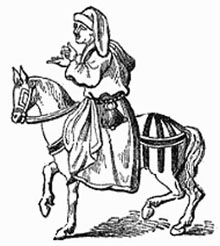 As villeins lost their farmland many landowners turned to raising sheep, which became highly valued because of their wool. The poor and hungry complained at heavier taxes (the third poll tax of 1377), the extra work burden because of labour shortages and new laws which attempted to peg wages back to pre-plague levels and restrictions to the mobility of labour. "Sheep eat Men," they cried and led by Wat Tyler, John Ball and Jack Straw the peasants revolted in 1381. Although the Peasants' Revolt failed it marked the beginning of the end of the feudal system and revealed the potential power of the people. As villeins lost their farmland many landowners turned to raising sheep, which became highly valued because of their wool. The poor and hungry complained at heavier taxes (the third poll tax of 1377), the extra work burden because of labour shortages and new laws which attempted to peg wages back to pre-plague levels and restrictions to the mobility of labour. "Sheep eat Men," they cried and led by Wat Tyler, John Ball and Jack Straw the peasants revolted in 1381. Although the Peasants' Revolt failed it marked the beginning of the end of the feudal system and revealed the potential power of the people.
The Hay-cockes in the Meades were so opprest
With plaguy Bodies; both alive and dead;
Which being us'd, confounded Man and Beast,
And us'd they might be ere discovered.
For some (like Ghosts) wold walk out in the night,
The Citie glowing (furnace-like) with heate
Of this contagion, to seeke if they might
Fresh aire, where oft they died for want of meate.
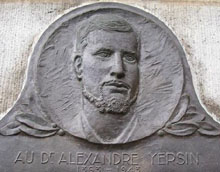 In 1894 Swiss-born Alexandre Yersin, physician and bacteriologist, discovered the pathogen that caused the plague in a victim's body in Hong Kong. Yersin retuned to France and was able to make an antitoxin. Two years later he returned to the Far East and became the first man to treat patients of the plague using an antibiotic serum. In 1894 Swiss-born Alexandre Yersin, physician and bacteriologist, discovered the pathogen that caused the plague in a victim's body in Hong Kong. Yersin retuned to France and was able to make an antitoxin. Two years later he returned to the Far East and became the first man to treat patients of the plague using an antibiotic serum.
What are those men but plagues, that plague but men?
All men are such, that teach sin in effect,
And all do so, that sinne but now and then,
If now and then they sinne, in overt act:
What can containe us, if these plagues cannot?
If neither these we feele, nor those we shall,
Be not of force to keep our lives from blot,
What then remaines but plagues to scowre us all?
Till we wax lesse, and they so multiplide,
That we be nothing lesse, than what we are;
Converted or confounded we abide
In, or without God, with or without care!
[Extracts from Humours Heaven on Earth, 1605, by John Davies of Hererford]
The plague still exists in the wild. There are occasional outbreaks in sub-Saharan Africa, Asia and USA. If caught early it can be successfully treated with antibiotics.
Malcolm J. Casadaban, 60, a University of Chicago molecular genetics professor, died earlier this year after exposure to the Yersina pestis bacterium in his laboratory.
Sources
Guide to Ledbury, E. Freeman
St Katherine's Hospital, Ledbury c.1230-1547, Joe Hillaby
A View of Hereford's Past, Richard Stone & Nic Appleton-Fox
Horrible Science & Horrible Histories, Nick Arnold & Tony De Saulles
The Complete Works of John Davies of Hereford
|